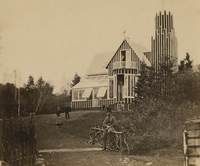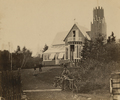
Source: Link
DOWNS, ANDREW, naturalist, ornithologist, taxidermist, and proprietor of a zoological garden; b. 27 Sept. 1811 in New Brunswick, N.J., son of Robert Downs and Elizabeth Plum; m. first Mary Elizabeth Matthews in Halifax, and they had four daughters; m. there secondly 22 June 1859 Mathilda E. Muhlig, and they had one daughter; d. there 26 Aug. 1892.
Andrew Downs is said to have arrived in Halifax in 1825 when his father, a Scot, relocated there from New Jersey. Initially Andrew apparently followed his father’s trade as a tinsmith (plumber). He met American ornithologist John James Audubon during Audubon’s visit to Nova Scotia in 1833 and afterwards corresponded with him. By 1838 Downs had established his interest in the wildlife of the province sufficiently to be appointed agent for “a gentleman who is desirous of forming a collection of the animals of Nova Scotia, for the purpose of presenting them to Scientific Institutions in England.” A member of the governing committee of the Halifax Mechanics’ Institute since 1835, Downs was an active proponent of establishing a provincial museum of natural history. His plan, circulated in November 1838, proposed a park for the study and enjoyment of zoology, ornithology, and flora, as well as a library.
Downs was not alone in his interest in the natural history of Nova Scotia. In 1842, pointing out that study of the province’s fauna was “a calling I have followed from my earliest days,” he applied to Lieutenant Governor Lord Falkland [Cary*] for the £250 grant the legislature had approved for a provincial museum in response to Thomas McCulloch*’s petition for support of his growing collection of Nova Scotian wildlife. Noting that the sum was insufficient to establish a reputable institution, Downs recommended that the new museum be annexed to the small existing collection of the mechanics’ institute. Nothing came of this suggestion. In May 1845 Downs was appointed assistant curator of the institute’s collection, and the following year he was named curator.
Starting in 1847, Downs established what became known as his zoological gardens. From an initial base of 5 acres at the head of the Northwest Arm his enterprise grew to 100 acres, with a greenhouse, aviary, and aquarium. Although in 1863 it was, according to the Novascotian, “as yet, little more than the nucleus of a Zoological Garden,” improvements in the next three years, facilitated by Downs’s increasing reputation and annual grants from the legislature, substantially expanded its scale and collections. The noisy, diverse assemblage of birds and animals was situated in an adapted natural habitat. Personal collecting was supplemented by donations arranged by British army personnel, importations from the Zoological Society of London, and Downs’s own work during three European trips in 1862, 1864 (when he visited English naturalist Charles Waterton), and 1867.
By the early 1860s the extent and diversity of Downs’s collections and rising public interest in natural history made his zoological gardens a favourite destination for Halifax organizations and visitors seeking a day’s outing. In 1865 a thousand visitors were reported on Halifax Natal Day (the anniversary of the arrival of Edward Cornwallis* in 1749). Every visiting Englishman – including the Prince of Wales, who toured the site in 1860 – recognized the fashionable scientific interest and picturesque qualities of Downs’s gardens. He was also extensively involved in arrangements for the collection and shipment of living animals to foreign princes and institutions, including King Victor Emmanuel II of Italy and the London zoo. As Campbell Hardy*, an ardent sportsman stationed with the British army in Halifax, later recounted, “Every visitor desirous of acquaintance with wild life in the woods or by the waters of Acadie, went to Downs for advice or reference.” In 1862 Downs was elected a corresponding member of the Zoological Society of London.
In addition to the local educational and recreational values of his zoological gardens, Downs took an active interest in the economic potential of animal culture. Arguing the opportunity in foreign markets for improved domestic fowl, he had obtained a legislative grant in 1853 to upgrade the breeding stock of his poultry yard. He imported 44 birds from England and that year won 11 prizes in the provincial poultry competition, which he had proposed be initiated to stimulate farmers to improve their stock. Encouraged by a further grant in 1856, he successfully acclimatized English pheasants and introduced Chinese sheep to the province.
Financially Downs depended on his skills as a taxidermist rather than on his interests as a naturalist, ornithologist, or breeder. Applying his firsthand knowledge and his thoroughly honed powers of observation, he was, as historian Charles Bruce Fergusson* has written, “a deft and painstaking workman.” His stuffed and mounted moose heads and his glass cases of game birds, wild ducks, and humming-birds won medals at the international exhibitions of 1851, 1862, 1865, and 1867, as well as regular prizes in local exhibitions, and his specimens were sent to private and institutional collections on both sides of the Atlantic. He claimed to have stuffed more than 800 moose heads in the course of his business. In Hardy’s words, “Few returned to Europe, after a sojourn . . . in the maritime provinces, without taking back either some trophy of the larger game or specimens of the beautiful avi-fauna of eastern Canada which had passed through our naturalist’s skilful hands.”
In 1867 Downs was recommended for the superintendency of the zoological collections of New York’s Central Park, apparently by Spencer Fullerton Baird, the eminent zoologist at the Smithsonian Institution. Although he had reportedly declined a similar offer in 1864, Downs sold his collections and property in Halifax and departed in mid 1868. American naturalist Charles Hallock later claimed that “some political jugglery” prevented Downs’s installation at Central Park. By early January the following year he was back in Halifax. Unable to repurchase his old site, he bought an adjacent property, which he soon fitted out in a picturesque manner with an aviary and expanding collections. But the venture was unsuccessful, and he sold out in 1872.
Little is known of Downs’s life over the next few years. In 1862 he had been active in the founding of the Nova Scotian Institute of Natural Science, where in 1865 he presented his first published paper. His next publications, in the 1880s, included his authoritative listing of Nova Scotian birds. In 1888 he delivered a paper on the same subject before the Royal Society of Canada. A member of organizing committees for exhibitions, he continued until his death in 1892 to express his commitments in such local organizations as the Nova Scotia Dog, Pigeon and Poultry Society and in the display and workmanship of his collections. Ultimately his investments in real estate and solid stocks gave him financial security.
Identified by contemporaries as having established the first zoological garden in North America north of Mexico, Andrew Downs encapsulated mid-19th-century interests in science, public parks, and healthful recreation. A recognized authority on Nova Scotian birds, in 1864 he was described as one “whose heart is in his work, if ever man’s was, and who has the liberality of spirit which all true lovers of nature have.”
Andrew Downs’s publications include three ornithological papers in the Nova Scotian Institute of Natural Science, Proc. and Trans. (Halifax): “On the land birds of Nova Scotia,” 1 (1863–66), pt.3: 38–51 and pt.4: 130–36; “Pied, or Labrador, duck,” 6 (1883–86): 326–27; and “A catalogue of the birds of Nova Scotia,” 7 (1886–90): 142–78.
PANS, RG 1, 275, no.86; RG 5, P, 19, 54. Francis Duncan, Our garrisons in the west or sketches of British North America (London, 1864). Charles Hallock, “The first American zoo,” Nature (New York), 1 (1889–90): 150–51; repub. as “Far ahead of his time: Andrew Downs, famous as scientist and naturalist . . . ,” Halifax Herald, 30 Aug. 1892. N.S., House of Assembly, Journal and proc., 1853, app.38, petition no.22; 1863: 107; 1866, app.36. Acadian Recorder, 26 March, 27 Aug., 19 Sept. 1864; 7, 21 Jan., 25 Feb., 23 June, 29 July, 19, 26 Aug., 2 Sept. 1865; 9 June, 11 Aug. 1866; 12, 15 June, 31 Aug. 1867; 28 March, 23 May 1868; 9 Jan. 1869. Evening Express and Commercial Record, 13 Sept. 1861, 29 June 1863, 8 May 1867. Evening Reporter (Halifax), 27 Nov. 1860. Halifax Herald, 27 Aug., 6 Sept. 1892. Illustrated London News, 24 Aug. 1867. Novascotian, 25 Aug., 20 Oct. 1856; 15 Feb. 1858; 6 Aug. 1860; 16 March 1863. Wesleyan (Halifax), 6 May, 10 Sept. 1838. John Quinpool [J. W. Regan], First things in Acadia, “the birthplace of a continent” (Halifax, 1936), 273–74. H. K. Swann, Nature in Acadia (London, 1895), 15. C. B. Fergusson, “Montezuma’s successor: Andrew Downs of Halifax,” Dalhousie Rev., 27 (1947–48): 261–80. Campbell Hardy, “Reminiscences of a Nova Scotian naturalist: Andrew Downs,” Nova Scotian Institute of Science, Proc. and Trans., 12 (1906–10): xi-xxix. Harry Piers, “Sketch of the life of Andrew Downs, founder of the first zoological garden in America,” Nova Scotian Institute of Science, Proc. and Trans., 10 (1898–1902): cii-cviii (portrait appears as frontispiece to volume).
© 1990–2024 University of Toronto/Université Laval
Image Gallery

Cite This Article
Susan Buggey, “DOWNS, ANDREW,” in Dictionary of Canadian Biography, vol. 12, University of Toronto/Université Laval, 2003–, accessed April 18, 2024, http://www.biographi.ca/en/bio/downs_andrew_12E.html.
The citation above shows the format for footnotes and endnotes according to the Chicago manual of style (16th edition). Information to be used in other citation formats:
| Permalink: | http://www.biographi.ca/en/bio/downs_andrew_12E.html |
| Author of Article: | Susan Buggey |
| Title of Article: | DOWNS, ANDREW |
| Publication Name: | Dictionary of Canadian Biography, vol. 12 |
| Publisher: | University of Toronto/Université Laval |
| Year of publication: | 1990 |
| Year of revision: | 1990 |
| Access Date: | April 18, 2024 |









